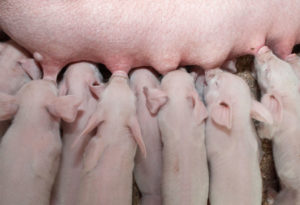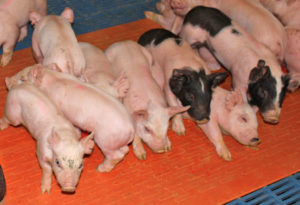Livestock farmers know that stressed animals don’t perform well. In a hog breeding and farrowing operation, uncomfortable conditions can negatively affect health, feed-to-gain ratios, and reproductive rates. One of the most common stressors for livestock are temperature extremes. Pigs have what’s called a narrow thermal neutral zone, or a small temperature window in which they feel comfortable. To reach that zone during the winter months, farmers often need to provide supplemental heat in the form of heating lamps or animal heat pads.
The thermal neutral zone for pigs varies by age.
- Pre-wean (suckling pig): 85+
- Wean pig (15 lbs.): 77-85
- Nursery pig (45 lbs.): 70-75
- Grower (55 lbs.): 68-75
- Grower (100 lbs.): 60-65
- Finishing (200 lbs.): 50-60
- Gestating sow (350 lbs.): 60-65
- Lactating sow (350 lbs.): 55-65
Cold stress causes pigs’ metabolism to rise, which helps them retain body heat. To make up for the extra energy expense, they consume more hog feed. Let that stress continue, and you may see stunted growth in young pigs and weight loss in mature pigs. The math is simple: Cold stress results in reduced profits. But which should you use — lamps or mats?
Which supplemental heat source is best?
Both options have pros and cons.
Heating lamps are inexpensive and readily available in farming stores. They’re easy to install and to move or repurpose if necessary. Their list of drawbacks, however, is long.
- They carry an increased risk of injury from glass breakage or electrical shock.
- They can provide too much heat if they’re hung too low, or insufficient heat if they’re raised to cover a larger area.
- Their bulbs burn out frequently, leaving the pigs without heat until a worker notices.
- They’re inefficient: Because heat rises, some of the lamp’s output never reaches the pigs and their energy consumption is higher than alternative heating methods.
Electric heat pads cover a larger area with consistent, even heat for all pigs, not just those directly under a lamp. You can avoid the guessing game and set mats to a precise temperature to create a warm microclimate exactly where it’s needed. Ideal for both farrowing and nursery animals, mats help piglets stay warm while sows benefit from the cooler air temps away from the heat source.
Heat mats cost more up front, but that initial investment is small potatoes when you consider the overall savings:
- Mats are more efficient, allowing you to reach your desired temperature with less energy and no waste.
- Mats are more durable, lasting decades if cared for properly.
- Mats don’t require continuous bulb replacement.
- Mats provide consistency and reliability, allowing for better stress management, which translates to better gain, lower mortality and, again, bigger profits.
Calculate your savings
How much can you save with mats? We developed an energy calculator to show you the difference in annual expenditures for each option. Enter your local energy costs, weaning age, some information on the area you need to heat, and the number of lamps you need, and we’ll provide a side-by-side comparison.
When you’re ready to make the switch to mats, check out Osborne’s Stanfield Heat Pads — the original animal heat pad used in pork production. The pads come in a variety of sizes and wattages, but all are made with water-resistant and flame-retardant materials and meet or exceed UL, CSA, CE, IEC and PSE standards for safe operation.
Learn more about Stanfield Heat Pads:



